Time and the Writers:
Models of Time in Literature, Science, and Busby Berkeley Films
essay by Etzel Cardeña
gifs by Lauren Reid
My theory being that the actual event practically does not exist – nor time either.
Virginia Woolf, writer (in Bell, 1982, p. 118)
[D]ue to nonseparability, the said “Real” may in no sensible way be considered constituted of localized elements embedded in space-time…
Bernard d’Espagnat, physicist and philosopher (2006, p. 454)
In his play Time and the Conways, J. B. Priestley takes that family through three acts from 1919 to 1937 and then back to 1919. A wrenching depiction of a group seeing their youthful illusions evaporate was not unusual, but the time twists were. Kay Conway has a disturbing vision in 1919 of their future failed lives, but her brother Alan promises that he will be able to tell her something in the future that will soothe her. In 1937 he reminds her of their previous interaction and reveals that our current sorrows are illusory as time is eternally present. Priestley, whose ideas about time were influenced by the ostensible precognitive dreams of the aeronautical engineer J. W. Dunne (1927/2001), is one of a number of writers who have had alternative views of time as a central motif in their works. Contra St. Augustine’s statement about it in his Confessions, not only may time be difficult to define, but we are not even sure of its nature.
There are various reasons why writers have questioned the typical linear account of time: their own personal experiences, theories from physics at the quantum and macro-levels, research on precognition and presentiment, mythical accounts of reality, and that timeless gadget called imagination:
Personal experiences: Not only have mystics like Meister Eckhart described their own experiences of a timeless/spaceless realm, but also ordinary individuals, whether exposed to a “near-death-experience,” hallucinogenic drugs, or just spontaneously (Wulff, 2014). Many writers have conveyed the experience of timelessness in their writings (e.g. T.S. Eliot’s Burnt Norton, “If all time is eternally present/All time is unredeemable…”; see also Borges, 2010; Durr, 1970), or have described their own ostensible precognitive experience (Cardeña, Iribas, & Reijman, 2012). In contrast with an intensification of the present, dissociative experiences include a discontinuous, jagged sense of time, with gaps in the immediate past or throughout one’s life.
Physics’ accounts of time: Einstein’s theories and the ensuing experiments have demonstrated beyond doubt that objectively measured time and space are not absolute and depend on variables such as the position and speed of the observers and gravitation. Thus, for an observer traveling at near the speed of light, matters that are still in your future may have already occurred to him/her (Davies, 2002). This has given rise to alternative models of time, including a block model in which past, present, and future coexist simultaneously, and it may be only our limited perception that engenders a sense of sequentiality of moments. At the molecular level, experiments on quantum retrocausality have shown that subatomic events that occur later can retroactively determine those that occur earlier (Sheehan, 2011).
Controlled experiments on precognition and presentiment have provided cumulative evidence that individuals’ conscious experience and their physiology may provide accurate, detailed information about future (or past) events that could not be otherwise inferred, and at higher levels than would be expected by chance (Cardeña, Palmer, & Marcusson-Clavertz, 2015; Honorton & Ferrari, 1989).
Mythical accounts of time are not necessarily incongruous with some contemporary physics models. The historian of religions Mircea Eliade (1964) described how some traditional cultures have juxtaposed the sequential profane time with a sacred one that can take different forms, including cyclical recreations of the universe and a timeless realm.
And writers and other artists also have recourse to the inexhaustible well of their own creativity and imagination.
We exemplify below various conceptions of time found in the work of some writers, and illustrate them with frivolous confections from Busby Berkeley’s films, coupling the sacred with the profane. Our list of conceptions is not exhaustive (for instance, we do not cover time travel because it could be explained according to different models) and many more examples could be adduced for the ones we discuss.

The common experience of time is that there is only a sliver of a moment, coming from a previous one and always transforming into the next. Our sense of continuity, or “specious present” depends on the overlap in consciousness of the current with recent movements, and an anticipation of immediate future ones (Marshall, 2015). Every experience is transient and unrepeatable, with all conducing to the same end among living organisms, as the 15th century writer Jorge Manrique wrote in his Coplas a la Muerte de su Padre, “Nuestras vidas son los ríos/que van a dar en la mar,/qu’es el morir” (Our lives are rivers, gliding free/To that unfathomed, boundless sea,/The silent Grave! [Henry Wadsworth Longfellow, trans.])
Taking a different approach, some have depicted the ongoing dynamic sequence of flowing moments, as in James Joyce’s sentence from Finnegan’s Wake, “Beside the rivering waters of, hitherandthithering waters,” whereas others have sought to preserve the current moment by invoking its sensory presence repeatedly, trying to short-circuit associations or distractions. The modernist “stream of consciousness” writer Gertrude Stein (also a student of psychologist/philosopher William James who coined that term) tried to arrest the passage of time and extend the present in a line of her poem Sacred Emily, “Rose is a rose is a rose is a rose.”
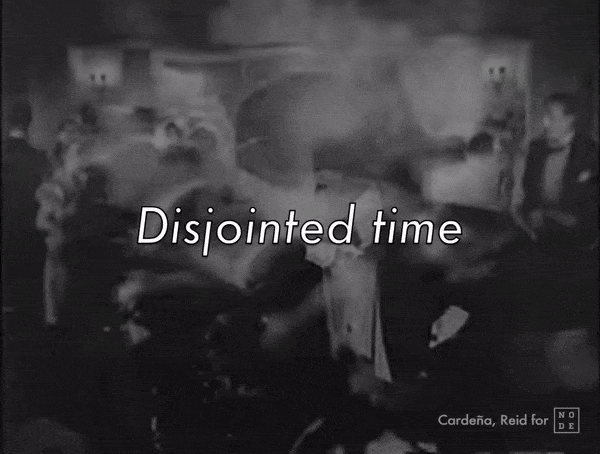
The experience of continuity, however, is far from absolute. Not only is it shattered in the case of brain damaged patients who may suddenly feel that they were completely unconscious until they became co
nscious a moment before (Restak, 1984), but it can happen to those with dissociative (psychogenically caused) amnesias, with lacunae for recent or distant memories they should remember (Cardeña, 1994). But even without any type of neurological or psychological problem, we all share disjointed time every day, both during dreams and when waking up. During non-lucid dreams, we find ourselves suddenly in a situation without any sense of our preceding history, and after we wake up we have little to no recollection of our dreaming experiences.
In literature, a famous early attempt to subvert the typical sequence of a literary account is Laurence Sterne’s The Life and Opinions of Tristram Shandy, Gentleman, whose first volumes were published in 1759. The eponymous hero tries to offer a narrative of his life, but is constantly frustrated by associations and distractions. Sterne also introduces other forms of discontinuity by interspersing blank pages, a page all in black, and even a couple of marble-patterned ones. August Strindberg’s masterpiece A Dream Play brought into theatre the temporal disjunction of dreams, in which a year for a human character is described as a minute for the daughter of a God (Indra’s daughter), and in which “The Officer” visibly ages while those around him do not, but returns at the end of the play in his initial age.
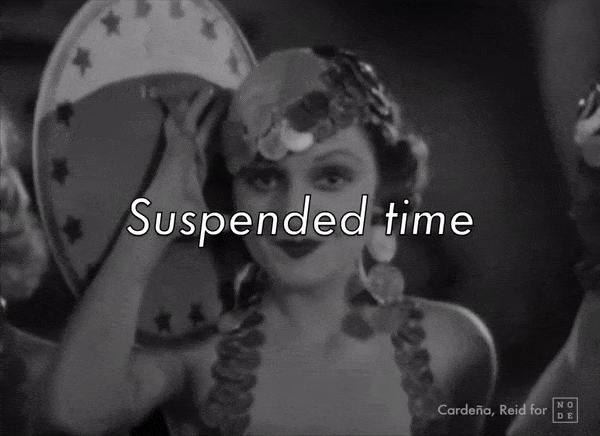
Experienced time depends on our homocentric metric that disregards the modes of other living beings that hibernate or whose reproduction or even breathing may occur every thousands of years (Saey, 2016). The suspension of the passage of time for humans has been described in different ways. Before the advent of recent technologies, Edgar Allan Poe published in 1845 The Facts in the Case of M. Valdemar, in which a dying man is hypnotized and left in a “suspended hypnotic state” during which he dies but remains in limbo, unable to live or to fully die. He communicates from yonder the horror of his pseudoexistence but remains in that state for months until he is dehypnotized, and the months-long putrefaction of his body ensues instantaneously (there is a radio-theatre adaptation of this short story, available in Spanish here).
Moving from hypnosis to technology, Don DeLillo’s novel Zero K occurs in a compound in which the dying (or those who want to join them) are cryogenically frozen and their death suspended until an uncertain future in which they may be revived. Further, a horrifying view of suspended animation with an experienced decay of reality was portrayed in Philip K. Dick’s novel Ubik.
Clark Ashton Smith described the potential horror of a never changing landscape during space travel in his short story Master of the Asteroid. In it, three astronauts are immersed in a space so vast that nothing seems to change. Their sense of being “perfectly stationary in a static void” makes an astronaut experience that he is sinking through a bottomless space, while another goes on a murdering rampage. In a lighter variation of the theme of suspension, time does not stop for the main character but for everyone else in Nicholas Baker’s The Fermata, which describes the ribald adventures of Arno Strine, who has learned how to pause time so he can become a voyeur of women.
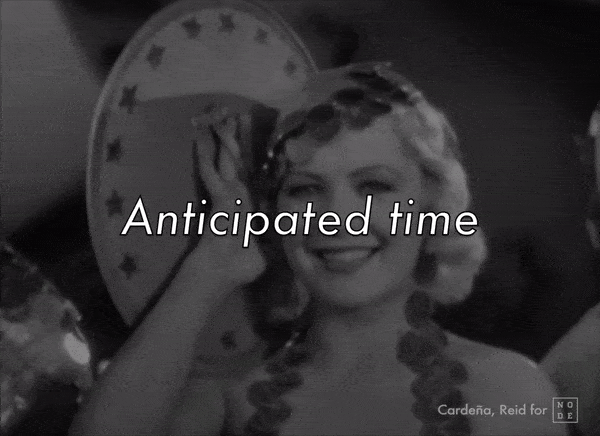
There is no dearth of accounts in various mythological and religious traditions of individuals being able to foretell the future, either through mantic practices such as looking into the innards of a sacrificed animal, the induction of altered states (as with the Greek sybils), and/or as a special gift from the divinity (as with Biblical prophets). The gift of prophecy may, however, come at a heavy price. In the myth of Cassandra (depicted in The Trojan Women, by Euripides), daughter of the Kings of Troy, Apollo grants her the gift of seeing the future along with the curse of having no one believe what she says. In the novella The Lifted Veil by George Eliot (Mary Ann Evans), Latimer only reaps grief from his prophetic gift. In contrast, precognition comes as a relief in J. B. Priestley’s Time and the Conways, mentioned above.

In poetry, Guillaume Apollinaire has likely been the most influential practitioner of written and drawn poems in circular and other shapes, which could be read ad infinitum (e.g., his Miroir or Mirror poem). In prose, Adolfo Bioy Casares offers a technological variation in his La Invención de Morel (The Invention of Morel), in which the eponymous character devises an invention that completely records (including conscious states) all that transpires between him and his friends on an island for a few days. Those days are then replayed/re-experienced again and again, and will continue coming back as long as the projectors function, although the original actors are no longer around because the process of recording caused their premature death. And then we have the perfect circularity of Joyce’s sophisticated romp Finnegan’s Wake, in which the final sentence of the book is completed in its first one: “A way a lone a last a loved a long the /riverrun, past Eve and Adan’s, from swerve of shore to bend of bays…”

Although physics equations function the same forwards or backwards, it has been proposed that because of the second law of thermodynamics (in a closed system entropy or “disorder” increases with time) time cannot be reversed (Sagan, 2013). The “time arrow” implied by this law is endorsed by the precocious Thomasina, in Tom Stoppard’s theatrical masterpiece Arcadia, who concludes that the universe cannot repeat itself but will eventually end.
In contrast, a reversed time model in literature shifts the sequence of past-present-future to future-present-past. The Curious Case of Benjamin Button (made into a film with the same title), a short story by F. Scott Fitzgerald, chronicles the life of its hero, born as a speaking 70-year-old who in the course of the plot becomes a middle-aged man, a youngster and ends in kindergarten as the memory of his previous life fades away. A more ambitious work is Martin Amis’s Time’s Arrow: or the Nature of the Offence, in which not only a Nazi doctor revisits his life in reverse, becoming a healer rather than a murderer in Treblinka and Auschwitz, but everything else also goes in reverse, with mosquitoes being invoked by a slap on the skin so that they can give us blood to alleviate our pain and itching.
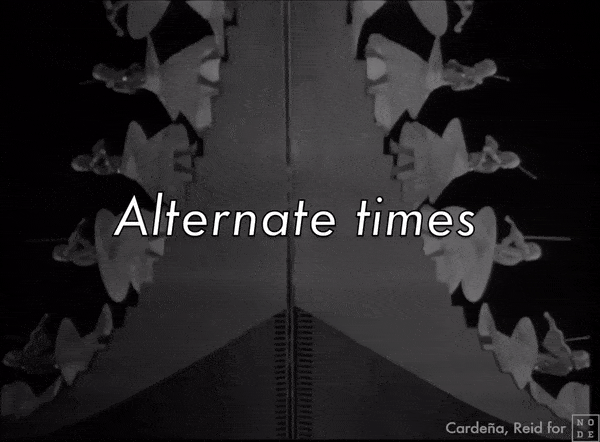
The physicist Hugh Everett’s interpretation of the probabilistic nature of reality at the quantum level is that multiple, perhaps an infinite numbers of worlds or universes, are constantly created, from the realization of potential quantum probabilities (Joseph, 2014). A somewhat related idea is presented in the “quantic” novel Vidas Perpendiculares by Álvaro Enrigue, in which Jerónimo simultaneously relives his various incarnations as a neglected Mexican boy growing up, a Greek maiden, a prehistoric youngster, and others. This goes well beyond the seemingly accurate memories of some children who recall previous lives (Cardeña et al., 2015) to the parallel re-experiencing of them. A whimsical example occurs in Stoppard’s Arcadia, in which characters from different times (1812 and “the present”) coincide on stage simultaneously, and their interactions are appropriate not only for their time but also, in parallel, for the alternate time.
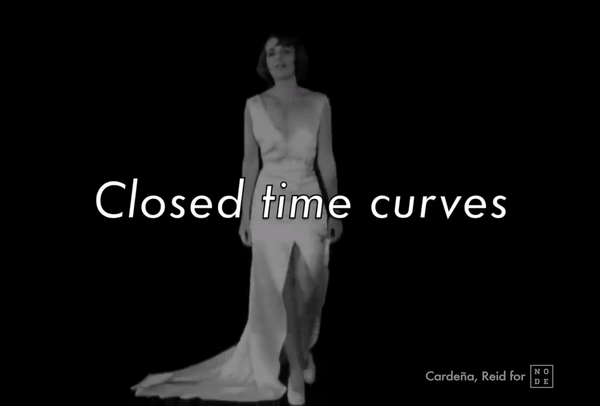
This is probably the most challenging view of time as it not only postulates that the future can affect the past but, paradoxically, that an effect can be the cause of itself. The logician, mathematician, and philosopher Kurt Gödel postulated that, considering the curvature of space-time, a traveler at a greater than the speed of light might go back into the past, in a closed time curve in which it would cause itself (Joseph, 2014). A dizzying literary (in the visual arts one can think of Escher’s Drawing Hands) example is Robert Heinlein’s short story ‘-All you Zombies-‘ (filmed as Predestination), in which the main character is shown to have been, at different moments, a woman (with an additional set of male organs), the man who has come back from the future to impregnate her, and the baby that will become him/her.
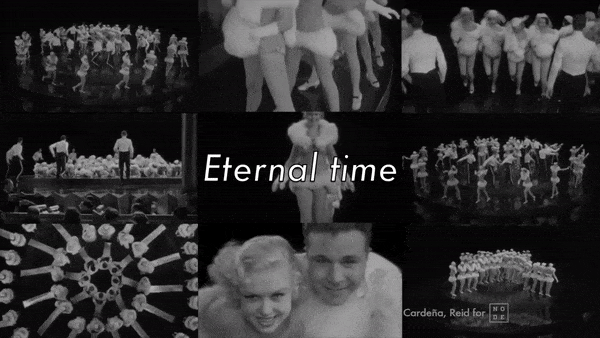
The core of a mystical experience is a sense of unity with everything there is, along with an abeyance of the ordinary sense of time and space, sometimes described as an eternal present (Wulff, 2014). The religious writer Yvonne Lubbock (in Marshall, 2015, p. 49) described it as: “a feeling of timelessness, not only that time stood still, that duration had ceased, but that I was myself outside time altogether.” The poet Jorgue Guillén wrote thus of his experience in Las Doce en el Reloj, “Centro en aquel instante/De tanto alrededor/Quien lo veía todo/Completo para un dios. Dije: Todo, completo” (Center in that moment/Of so much surrounding/Who observed everything/As full as a god/I said: Everything, complete [Etzel Cardeña, trans.]).
In his story El Aleph, the writer Jorge Luis Borges as the character “Borges” encounters the mythical Aleph, a small iridescent sphere at the bottom of a basement stair. In its 2-3 cm diameter, everything happening everywhere in the cosmos from every perspective is simultaneously perceivable. “Borges” apologizes for having to use language, which is sequential and limited, to enumerate infinite perspectives on everything in the cosmos: a mirror seen from every conceivable perspective, the masses in America, snow, tobacco, the corpse of his beloved who had recently died, sunsets, dawn, and the more justified etc. in literature. The infinitude of the cosmos in a small apartment echoes the belief of some traditional cultures that in profane time there are apertures through which sacred time can manifest (Eliade, 1964).
Potential explanations for this experience can be found in modern physics. Quantum theoretician David Bohm (1980) postulated an implicate order, which precedes time-space differentiation and is foundational for the surface reality that we perceive as an explicate order (cf. also physicist d’Espagnat’s [2006] notion of a unified veiled reality, inapprehensible by the human mind).
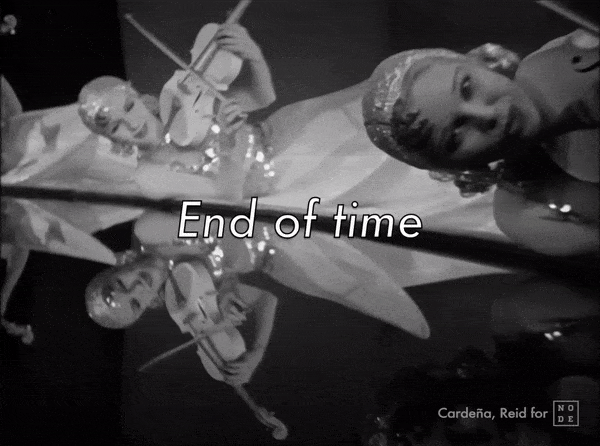
The end of time, as compared with the end of the human species, defies imagination. Whereas the latter has been presented in dystopic novels by Margaret Atwood, Cormac McCarthy, and others, the complete cessation of time cannot be encompassed by language. No literature can be made of that nothingness, and whatever attempts have been made partake of paradoxes. Likely the most famous account in the West is in the Apocalypse or The Revelation of St. John the Divine (King James Version) in which the Almighty appears as “Alpha and Omega, the beginning and the ending… which is, and which was, and which is to come.” Arthur C. Clarke presents a technological version of the Omega in his short story The Nine Billion Names of God, in which a computer finishes its task of determining all the names of the divinity. At that point, one of the characters signals to the other as “Overhead, without any fuss, the stars were going out.”
Finally, Borges, now as a poet, uses his imagination to preserve a personal dimension of the end of times in his Del Infierno y del Cielo:
“cuando el juicio retumbe en las trompetas/últimas y el planeta milenario/sea obliterado y bruscamente cesen/¡oh Tiempo! tus efímeras pirámides,/los colores y líneas del pasado/definirán en la tiniebla un rostro/durmiente, inmóvil, fiel, inalterable/(tal vez el de la amada, quizá el tuyo)/y la contemplación de ese inmediato/rostro incesante, intacto, incorruptible,/será para los réprobos, Infierno;/para los elegidos, Paraíso.”
(when Judgment Day sounds in the last trumpets/and planet and milleniums both/disintegrate, and all at once, O Time,/all your ephemeral pyramids cease to be,/the colors and the lines that trace the past/will in the semi-darkness form a face,/a sleeping face, faithful, still, unchangeable/(the face of the loved one, or, perhaps, your own)/and the sheer contemplation of that face -/never-changing, whole, beyond corruption-/will be, for the rejected, an Inferno,/and, for the elected, Paradise. [Alastair Reid, trans.]).
Bibliography
Bell, A. O. (Ed.) (1982). The diary of Virginia Woolf. Vol. 3, 1925-1930. London, UK: Penguin.
Bohm, D. (1980). Wholeness and the implicate order. London, UK: Routledge.
Borges, J. L. (2010). On mysticism. London, UK: Penguin.
Cardeña, E. (1994). The domain of dissociation. In S. J. Lynn & J. W. Rhue (Eds.) Dissociation: Clinical and theoretical perspectives (pp. 15-31). New York, NY: Guilford.
Cardeña, E., Iribas, A., & Reijman, S. (2012). Art and psi. Journal of Parapsychology, 76, 3-25.
Cardeña, E., Palmer, J., & Marcusson-Clavertz, D. (2015). Parapsychology: A handbook for the 21st century. Jefferson, NC: McFarland.
Davies. P. (2002, September). That mysterious flow. Scientific American, pp. 40-47.
d’Espagnat, B. (2006). On physics and philosophy. Princeton, NJ: Princeton University Press.
Dunne, J. W. (2001). An experiment with time. Charlottesville, VA: HamptonRoads. (Originally published 1927)
Durr, R. A. (1970). Poetic vision and the psychedelic experience. Syracuse, NY: Syracuse University Press.
Eliade, M. (1964). Traité d’ histoire des religions (Treaty on the history of religions). Paris, France: Payot.
Grant, A. (2015). Time’s arrow. Science News, 188(2), 15-18.
Honorton, C., & Ferrari, D. C. (1989). “Future telling”: A meta-analysis of forced-choice precognition experiments, 1935-1987. Journal of Parapsychology, 53, 281-308.
Joseph, R. H. (2014). The time machine of consciousness. Past present future exist simultaneously. Cosmology, 18, 331-375.
Marshall, P. (2015). Mystical experiences as windows on reality. In E. F. Kelly, A. Crabtree, & P. Marshall (Eds.), Beyond physicalism: Toward reconciliation of science and spirituality (pp. 39-76). Lanham, MD: Rowman & Littlefield.
Restak, R. (1984). The brain. New York, NY: Bantam.
Saey, T. H. (2016). Will we know ET when we see it? Science News, 189 (9), 28-31.
Sagan, D. (2013). Cosmic apprentice: Dispatches from the edges of science. Minneapolis, MN: University of Minnesota Press.
Sheehan, D. P. (Ed.). (2011). Quantum retrocausation—Theory and experiment. AIP Conference Proceedings 863. Melville, NY: American Institute of Physics.
Wulff, D. M. (2014). Mystical experiences. In E.Cardeña, S. J. Lynn, & S. Krippner (Eds.), Varieties of anomalous experience: Examining the scientific evidence (2nd ed., pp. 369–408). Washington, DC: American Psychological Association. http://dx.doi.org/10.1037/14258-013
This article was produced for Node Center for Curatorial Studies in 2016.
The gifs in the article are licensed under a Creative Commons Attribution-NonCommercial-ShareAlike 4.0 International License.
